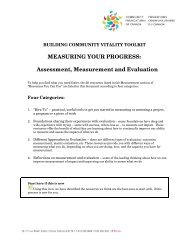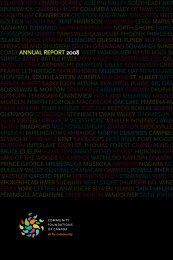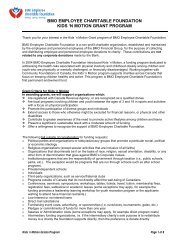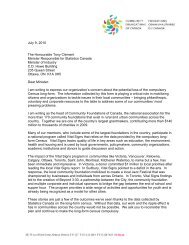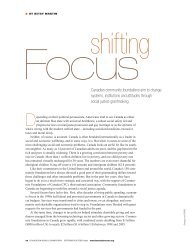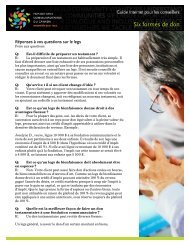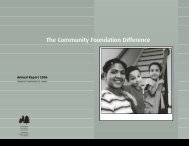Aboriginal Philanthropy in Canada: A Foundation for Understanding
Aboriginal Philanthropy in Canada: A Foundation for Understanding
Aboriginal Philanthropy in Canada: A Foundation for Understanding
You also want an ePaper? Increase the reach of your titles
YUMPU automatically turns print PDFs into web optimized ePapers that Google loves.
Wendy Scaife, <strong>in</strong> answer to the question of why giv<strong>in</strong>g to<br />
Indigenous causes warrants special <strong>in</strong>terest, states that<br />
firstly, Indigenous needs are some of the deepest <strong>in</strong> society<br />
and span fund<strong>in</strong>g arenas as diverse as conservation, health,<br />
youth, education, hous<strong>in</strong>g, economic development, poverty,<br />
world peace, human rights, arts, employment, susta<strong>in</strong>able<br />
development and social justice. Further, from an impact<br />
perspective, the world’s 350 million Indigenous people spread<br />
across 90 countries contribute largely to the world’s cultural<br />
diversity, and some 80 per cent of the world’s rema<strong>in</strong><strong>in</strong>g<br />
biodiversity is found with<strong>in</strong> their lands (International Funders<br />
<strong>for</strong> Indigenous Peoples 2006; Funders Network 2006) 11 .<br />
Accord<strong>in</strong>g to Statistics <strong>Canada</strong>, <strong>in</strong> 2007 Canadians donated<br />
$10 billion dollars to charitable <strong>in</strong>stitutions 12 . Yet little of this<br />
fund<strong>in</strong>g f<strong>in</strong>ds its way to <strong>Aborig<strong>in</strong>al</strong> communities, <strong>in</strong> spite of<br />
the obvious need and regardless of the responsibility that<br />
government, bus<strong>in</strong>ess and philanthropy share <strong>for</strong> the wellbe<strong>in</strong>g<br />
of <strong>Aborig<strong>in</strong>al</strong> peoples and communities. This is the<br />
unrealized opportunity that we seek to understand and to<br />
<strong>in</strong>troduce <strong>in</strong>to the dialogue between <strong>Aborig<strong>in</strong>al</strong> Peoples and<br />
foundations. The time is ripe to change the relationships<br />
between foundations and <strong>Aborig<strong>in</strong>al</strong> communities. A grow<strong>in</strong>g<br />
number of philanthropic foundations <strong>in</strong> <strong>Canada</strong> want to<br />
learn about and deepen their engagement with <strong>Aborig<strong>in</strong>al</strong><br />
communities. This <strong>in</strong>cludes community foundations, which<br />
operate at a local and typically urban scale, as well as<br />
corporate, private and family foundations, which<br />
operate at regional, national or even <strong>in</strong>ternational<br />
scales. Change at every level is with<strong>in</strong> our reach.<br />
“Decisions are<br />
made based<br />
on emotions.”<br />
11<br />
Scaife (2006), page 1.<br />
12<br />
Hall, Lasby et al (2009).<br />
The Circle on <strong>Philanthropy</strong> & <strong>Aborig<strong>in</strong>al</strong> Peoples <strong>in</strong> <strong>Canada</strong> 18





